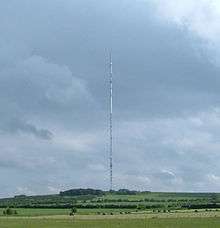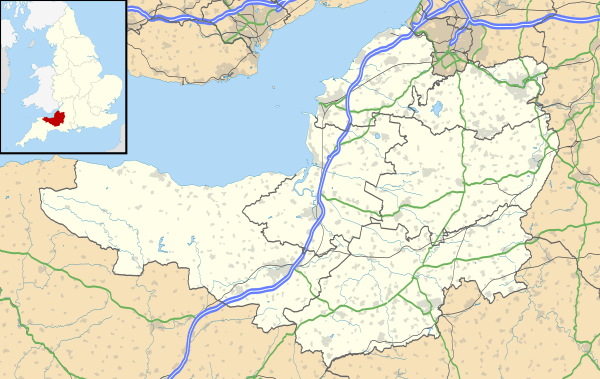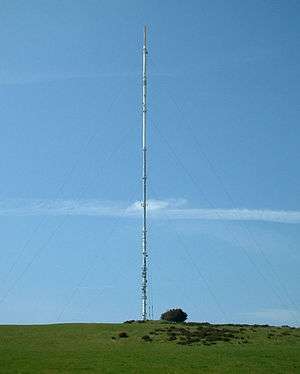Mendip transmitting station
The Mendip transmitting station is a broadcasting and telecommunications facility on the summit of Pen Hill, part of the Mendip Hills range in Somerset, England, at 305 metres (1,001 ft) above sea level. The station is in St Cuthbert Out civil parish in Mendip district, approximately 2 miles (3.2 km) northeast of the centre of Wells. It has a 281.6 metres (924 ft) tall mast, which was built in 1967 and weighs around 500 tonnes, and is the tallest structure in South West England. The mast broadcasts digital television, FM analogue radio and DAB digital radio, and had broadcast analogue colour television from 1967 until 2010. It has become a Mendip landmark, providing a method of identifying the hills from a distance.
 The Mendip UHF television mast | |
 Mendip transmitting station (Somerset) | |
| Mast height | 293 metres (961 ft) |
|---|---|
| Coordinates | 51.2370°N 2.6253°W |
| Grid reference | ST564488 |
| Built | 1967 |
| BBC region | BBC West |
| ITV region | ITV West |
| Local TV service | Made in Bristol |

Description
The station is owned and operated by Arqiva (which acquired National Grid Wireless, previously Crown Castle).
Until 2008 a GRP aerial cylinder, containing the analogue television transmitting antennas, was mounted at the top of the mast, bringing the total height of the structure to 305 metres (1,001 ft). With a mean height of 596 metres (1,955 ft) above sea level, these antennas were among the highest in the UK. They were removed in 2010, the antenna cylinder being replaced with a new antenna assembly, ready for digital switchover later that year. The present assembly is slightly shorter than the previous cylinder, causing the overall mast height to be reduced from 305 metres (1,001 ft) to 293 metres (961 ft).[1]
There are red aircraft warning lamps (six sets of two lights) on the mast and two lights on top. The lights were upgraded in February 2007[2] to comply with CAA 2000 Air Navigation Order, designed to prevent low flying aircraft from hitting the mast.
The mast was repainted during 2007.
The mast can be seen from as far away as Puriton during the day and the red aircraft warning lights make it visible at night from pretty much anywhere on the Somerset Levels.
Television
Mendip was set up as a C/D group transmitter when it entered service with analogue PAL transmissions. In July 2007, Ofcom confirmed that it would remain a C/D group transmitter at digital switchover. The mast broadcasts digital television over a large area of the west of England, including Somerset, Wiltshire, North Somerset, Bath and North-East Somerset, Bristol, South Gloucestershire, Southern Gloucestershire, Northern Dorset and East Devon.
The station also covers the coastal areas of south east Wales, and in the days of analogue TV, many households used it in preference to their more local station, Wenvoe. This is because prior to the digital switchover, Mendip carried Channel 4 and Channel 5, whereas Wenvoe only carried S4C, which broadcast a lot of Welsh language programming.
Power on analogue transmissions was 500 kW (erp) on channels 1 to 4, and 126 kW on Channel 5. The latter was transmitted outside of the original C/D grouping of the transmitter but most people in reasonable signal areas could receive it. All six digital multiplexes were transmitted at 10 kW until switchover in 2010 when the power on the "BBC A", "BBC B/HD" and "D3&4" multiplexes was boosted to 100 kW. In 2011, SDN was boosted to 50 kW and in 2012 the remaining two Arqiva multiplexes were boosted to 50 kW too. In June 2019, as part of the 700MHz clearance, Mendip became a K group (excluding MUXES 7 and 8, which are due to be switched off between 2020 and 2022 anyway). This means those who still have C/D group aerial may struggle to receive all channels, particularly if the site is in a poor signal area (see Mendip graph).
Mendip's population coverage is around 1.5 million, although some homes in the immediate vicinity, such as those in Cheddar, are unable to receive a signal due to being in the shadow of the Mendip Hills and therefore depend on local relays.
Radio
Mendip broadcasts FM (analogue VHF) radio for BBC Somerset and the Severn Estuary regional service Kiss 101. It transmits high power Digital Audio Broadcasting (DAB) signals for Digital One and BBC National DAB multiplexes, and until 2013 transmitted a lower power local service to Glastonbury for MXR Severn Estuary. These three multiplexes carry approximately ten digital radio stations each. An additional DAB multiplex, MuxCo Somerset, was awarded a licence in 2008 to broadcast local and national services to Somerset, and began transmission in 2014.[3]
Output
Radio
Analogue
| Frequency | kW[4] | Service |
|---|---|---|
| 95.5 MHz | 5 | BBC Somerset |
| 101.0 MHz | 40 | Kiss 101 |
| 102.6 MHz | 4 | Heart Somerset |
Digital
| Frequency | Block | kW[5] | Operator |
|---|---|---|---|
| 211.648 MHz | 10B | 1.2 | MuxCo Somerset |
| 216.928 MHz | 11A | Sound Digital Limited | |
| 222.064 MHz | 11D | 5 | Digital One |
| 225.648 MHz | 12B | 5 | BBC National DAB |
| 227.360 MHz | 12C | 1.25 | South East Wales |
Television
Analogue
30 May 1970 – 2 November 1982
| Frequency | UHF | kW | Service |
|---|---|---|---|
| 767.25 MHz | 58 | 500 | BBC1 |
| 791.25 MHz | 61 | 500 | HTV West |
| 815.25 MHz | 64 | 500 | BBC2 |
2 November 1982 – 30 March 1997
| Frequency | UHF | kW | Service |
|---|---|---|---|
| 735.25 MHz | 54 | 500 | Channel 4 |
| 767.25 MHz | 58 | 500 | BBC1 |
| 791.25 MHz | 61 | 500 | HTV West |
| 815.25 MHz | 64 | 500 | BBC2 |
30 March 1997 – 15 November 1998
| Frequency | UHF | kW | Service |
|---|---|---|---|
| 599.25 MHz | 37 | 126 | Channel 5 |
| 735.25 MHz | 54 | 500 | Channel 4 |
| 767.25 MHz | 58 | 500 | BBC One |
| 791.25 MHz | 61 | 500 | HTV West |
| 815.25 MHz | 64 | 500 | BBC Two |
Analogue and digital
15 November 1998 – 24 March 2010
Digital terrestrial television was first transmitted from the Mendip mast from 15 November 1998 using the frequency gaps between the analogue TV broadcasts. To limit interference to the analogue transmissions, power output on the digital multiplexes was low.
| Frequency | UHF | kW | Operator | System |
|---|---|---|---|---|
| 599.25 MHz | 37 | 126 | Channel 5 | PAL System I |
| 735.25 MHz | 54 | 500 | Channel 4 | PAL System I |
| 746.166 MHz | 55+ | 10 | Digital 3&4 (Mux 2) | DVB-T |
| 754.166 MHz | 56+ | 10 | Arqiva (Mux C) | DVB-T |
| 767.25 MHz | 58 | 500 | BBC One | PAL System I |
| 778.166 MHz | 59+ | 10 | BBC (Mux 1) | DVB-T |
| 791.25 MHz | 61 | 500 | ITV1 (HTV West until 2002) | PAL System I |
| 802.166 MHz | 62+ | 10 | SDN (Mux A) | DVB-T |
| 815.25 MHz | 64 | 500 | BBC Two | PAL System I |
| 826.166 MHz | 65+ | 10 | BBC (Mux B) | DVB-T |
| 842.000 MHz | 67 | 10 | Arqiva (Mux D) | DVB-T |
24 March 2010 – 7 April 2010
On 24 March 2010 BBC Two was switched off on UHF 64 and ITV1 was switched from UHF 61 for its final weeks of service. Multiplex 1 on UHF 59+ was closed and replaced by BBC A on UHF 61 (which had just been vacated by analogue ITV1). BBC A was transmitted at full power (100 kW) and in 64QAM, 8k carriers mode from the start.
| Frequency | UHF | kW | Operator | System |
|---|---|---|---|---|
| 599.25 MHz | 37 | 126 | Channel 5 | PAL System I |
| 735.25 MHz | 54 | 500 | Channel 4 | PAL System I |
| 746.166 MHz | 55+ | 10 | Digital 3&4 (Mux 2) | DVB-T |
| 754.166 MHz | 56+ | 10 | Arqiva (Mux C) | DVB-T |
| 767.25 MHz | 58 | 500 | BBC One | PAL System I |
| 794.000 MHz | 61 | 100 | BBC A | DVB-T |
| 802.166 MHz | 62+ | 10 | SDN (Mux A) | DVB-T |
| 815.25 MHz | 64 | 500 | ITV1 | PAL System I |
| 826.166 MHz | 65+ | 10 | BBC (Mux B) | DVB-T |
| 842.000 MHz | 67 | 10 | Arqiva (Mux D) | DVB-T |
Digital
7 April 2010 – 28 September 2011
Following the completion of analogue TV shutdown on 7 April 2010, Mendip transmitted all of its higher powered multiplexes at 100 kW. From this date until the second-stage switchover of 28 September 2011 the frequency allocation was:
| Frequency | UHF | kW | Operator | System |
|---|---|---|---|---|
| 738.000 MHz | 54 | 100 | Digital 3&4 | DVB-T |
| 754.166 MHz | 56+ | 10 | Arqiva A | DVB-T |
| 770.000 MHz | 58 | 100 | BBC B | DVB-T2 |
| 794.000 MHz | 61 | 100 | BBC A | DVB-T |
| 802.166 MHz | 62+ | 10 | SDN | DVB-T |
| 842.000 MHz | 67 | 26 | Arqiva B | DVB-T |
28 September 2011 – 28 March 2012
With the completion of digital switchover at Oxford, all multiplexes could be moved to their final channel allocations with the exception of Arqiva A. SDN increased to half its full power output (50 kW).
| Frequency | UHF | kW | Operator | System |
|---|---|---|---|---|
| 690.000 MHz | 48 | 50 | SDN | DVB-T |
| 722.000 MHz | 52 | 25.7 | Arqiva B | DVB-T |
| 738.000 MHz | 54 | 100 | Digital 3&4 | DVB-T |
| 770.000 MHz | 58 | 100 | BBC B | DVB-T2 |
| 794.000 MHz | 61 | 100 | BBC A | DVB-T |
| 842.000 MHz | 67 | 26 | Arqiva A | DVB-T |
28 March 2012 – 26 March 2013
On 28 March 2012 Arqiva A moved to its final channel allocation at UHF 56, after the completion of digital switchover at Salisbury. Arqiva A and B and SDN also increased to full power (100 kW) on this date.[6]
| Frequency | UHF | kW | Operator | System |
|---|---|---|---|---|
| 690.000 MHz | 48 | 100 | SDN | DVB-T |
| 722.000 MHz | 52 | 100 | Arqiva B | DVB-T |
| 738.000 MHz | 54 | 100 | Digital 3&4 | DVB-T |
| 754.000 MHz | 56 | 100 | Arqiva A | DVB-T |
| 770.000 MHz | 58 | 100 | BBC B | DVB-T2 |
| 794.000 MHz | 61 | 100 | BBC A | DVB-T |
27 March 2013 – 27 February 2018
BBC A moved from UHF 61 to UHF 49 to allow for the clearance of the 800 MHz band for 4G LTE mobile services.[7][8]
| Frequency | UHF | kW | Operator | System |
|---|---|---|---|---|
| 690.000 MHz | 48 | 100 | SDN | DVB-T |
| 698.000 MHz | 49 | 100 | BBC A | DVB-T |
| 722.000 MHz | 52 | 100 | Arqiva B | DVB-T |
| 738.000 MHz | 54 | 100 | Digital 3&4 | DVB-T |
| 754.000 MHz | 56 | 100 | Arqiva A | DVB-T |
| 770.000 MHz | 58 | 100 | BBC B | DVB-T2 |
27 February 2018 - 4 April 2019
Arqiva A has moved from UHF 56 to UHF 33 for the start of the 700MHz clearance programme at Mendip.
| Frequency | UHF | kW | Operator | System |
|---|---|---|---|---|
| 570.000 MHz | 33 | 100 | Arqiva A | DVB-T |
| 690.000 MHz | 48 | 100 | SDN | DVB-T |
| 698.000 MHz | 49 | 100 | BBC A | DVB-T |
| 722.000 MHz | 52 | 100 | Arqiva B | DVB-T |
| 738.000 MHz | 54 | 100 | Digital 3&4 | DVB-T |
| 770.000 MHz | 58 | 100 | BBC B | DVB-T2 |
4 April 2019 – 5 June 2019
BBC A has moved from UHF 49 to UHF 32 as part of the 700MHz clearance programme at Mendip.
| Frequency | UHF | kW | Operator | System |
|---|---|---|---|---|
| 562.000 MHz | 32 | 100 | BBC A | DVB-T |
| 570.000 MHz | 33 | 100 | Arqiva A | DVB-T |
| 690.000 MHz | 48 | 100 | SDN | DVB-T |
| 722.000 MHz | 52 | 100 | Arqiva B | DVB-T |
| 738.000 MHz | 54 | 100 | Digital 3&4 | DVB-T |
| 770.000 MHz | 58 | 100 | BBC B | DVB-T2 |
5 June 2019 - Present
Digital 3&4 has moved from UHF 54 to UHF 34, and BBC B have moved as well from UHF 58 to UHF 35 as part of the 700MHz clearance programme at Mendip.
| Frequency | UHF | kW | Operator | System |
|---|---|---|---|---|
| 562.000 MHz | 32 | 100 | BBC A | DVB-T |
| 570.000 MHz | 33 | 100 | Arqiva A | DVB-T |
| 578.000 MHz | 34 | 100 | Digital 3&4 | DVB-T |
| 586.000 MHz | 35 | 100 | BBC B | DVB-T2 |
| 594.000 MHz | 36 | 100 | Arqiva B | DVB-T |
| 690.000 MHz | 48 | 100 | SDN | DVB-T |
See also
- List of masts
- List of radio stations in the United Kingdom
- List of tallest buildings and structures in Great Britain
References
- "Mendip". The Big Tower. Retrieved 6 April 2018.
- http://www.cheddarvalleygazette.co.uk/displayNode.jsp?nodeId=216909&command=displayContent&sourceNode=216903&contentPK=16636764&moduleName=InternalSearch&formname=filtersearch%5B%5D
- "South West England and Wales" (PDF). Frequency Finder. Archived from the original (PDF) on 19 February 2009. Retrieved 23 August 2011.
- Radio Listeners Guide 2010
- Radio Listeners Guide 2010
- http://www.digitaluk.co.uk/transmitternetwork/tools__and__resources/almanac/special_editions/Special_edition-installers_Mendip_retune_event_March2012_Final_rev23March.pdf
- Butterworth, Brian (13 January 2012). "2013 - post-switchover changes to Freeview transmission frequencies". ukfree.tv. Retrieved 22 July 2019.
- http://www.digitaluk.co.uk/when_do_i_switch/west